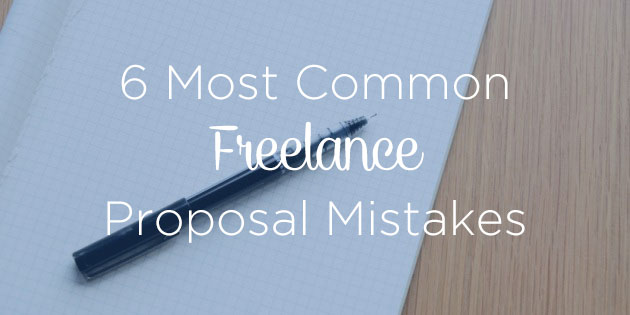Perhaps the most essential skill to master when launching or growing a freelance business, is perfecting your ability to find, pitch, and close the best possible clients for your business. That’s where crafting an amazing freelance proposal and cold email outreach campaign comes in.
It doesn’t matter if you’re the best writer, marketer, designer, or developer in the world. If you can’t effectively convince a potential client that you can deliver results that are going to help them achieve their goals, you’ll never have the chance to show off what you’re made of.
Whether you’re freelancing while working a full-time job, or you’re already self-employed, you need to take the time to learn and avoid these simple, yet prolific mistakes in your freelance proposals.
There’s certainly an art and science to winning the freelance clients you want for your business.
Once you’ve honed your ability to quickly and effectively understand your potential clients true needs and fully grasp how you can both address and communicate the positive impact your services on those deliverables, you’ll be in a much better position to win any contract you want.
As you perfect your freelance proposals and personal selling skills, you’ll quickly learn what works – and what doesn’t. I’ve already done a lot of that myself, so I’ll share the lessons I’ve learned along the way.
Focus on avoiding these 6 Most Common Freelance Project Proposal Mistakes with your business.
1. Using the Wrong Medium.
Is your proposal delivery method causing your client to do more work?
Closing freelance contracts is all about getting your potential clients excited for the results you can deliver, and reducing the friction between sending your proposal and getting it signed. The less work it takes to accept your proposal, the more contracts you’ll close.
If you’re sending your client a freelance proposal in the form of a word document, they’ll need to print it out, sign it, scan it to their computer, and then email it back to you. By taking this outdated route, you’re effectively creating multiple needless barriers to getting a quick yes. Something this simple can make the difference between a client choosing to go with another freelancer who’s using a less time-intensive solution.
By using an affordable online project proposal tool like Bidsketch, you’ll get the ability to create customizable proposals based on proven templates, and seamlessly deliver them to your clients with the ability for them to sign a contract electronically (even from their mobile devices). I personally use Bidsketch, and if you sign up using this link, you’ll get a free trial.
2. Making the Proposal Too Long.
In general, the shorter and more straight-to-the-point your proposal is, the more likely you’ll be to close the deal. A recent Bidsketch survey discovered that proposals that are less than 5 pages in length are 31% more likely to win business than those that are longer.
Let’s be honest, how much do you enjoy sitting through long powerpoint presentations, reading through long contracts, or emails? Know that your potential client is going to feel the same way about a long proposal. They’re just not going to be as excited about reading through something that’s appearing to be a major time investment, when stacked up against a shorter proposal.
I always quickly scan an email or document that’s sent my way and assess whether it’s going to be easy enough for me to address right now, or if it’s something I’ll push until later. Use the 2 Minute Rule to assess whether or not your proposal is too long before you send it. If your potential client can at least scan your proposal for the highlights in 2 minutes or less, then you’re on the right track.
3. Not Delivering the Proposal Quickly.
This one honestly defies all logic, in my opinion. If you’ve done everything right up to this point, you’ve successfully gotten your potential client excited about the idea of working with you and seeing the value in your expertise.
If you capture someone’s attention and they’re interested in evaluating the possibility of working with you on a project, you need to quickly present your service proposal and keep the excitement going. That same Bidsketch survey found that winning freelance proposals get to their clients on average, 26% faster than losing proposals.
In fact, the average winning proposal made it to the client in 2.7 days, compared to the average losing proposal which took 3.4 days to arrive. When you think about it, this makes perfect sense.
If you put yourself in the shoes of a growing brand that’s actively sourcing help with starting their content marketing program, they’re not going to be exciting about waiting any longer to get the initiative off the ground. They’re also very likely speaking with multiple freelancers they could go with for these services, so if your proposal makes it in first (I shoot for less than 48hrs from when we’ve decided to move forward with a proposal), you’re already that much more likely to be chosen quickly.
In addition to a quick delivery, it’s very important to establish a timeline for acceptance. Your potential client will understand that your time is limited, and that you’re sourcing more work in addition to just their project. I typically start with setting the expectation that I’ll need a decision within 7 days and will adjust from there, depending upon the scope of the project and the client’s internal approval process.
4. Not Using Pricing Psychology.
The foundation of understanding and maximizing pricing psychology with your freelance business, is mastering the practice of using value language—something you can learn more about in many of the top online business courses. When you emphasize the value of the services you’ll be providing for your client, and focus your conversation on the tangible results and longterm benefits you’ll be delivering, the emphasis is placed on results – not your hourly rate and time spent working.
When you’re building out the pricing/cost section of your proposal, instead use the term “Investment,” there and you’ll be completely shifting the focus of what your services are doing for the client. You’ll elicit a much different psychological response in the mind of your client, with this approach. An investment suggests that their resources are going toward creating results that will deliver a return to their business, where as “pricing” or “cost” simply implies money spent – void of any tangible returns.
If your services permit, consider bundle pricing where you can provide your client with one or two options for bundled services that’ll help them achieve their goals. If you’re a content marketer, this could be a package of 5 blog posts and a social media account audit, or 10 blog posts and 1 eBook.
5. Not Highlighting the Client’s Return on Investment.
Never assume that a potential client will automatically understand the benefits of working with you. It’s up to you to convince them that you’re the best choice.
Include an actual section in your proposal that very clearly highlights your client’s return on their investment. If you can effectively illustrate that the cost of purchasing your services will be greatly exceeded by the benefits of implementing them, you’ve already won a major victory in convincing the client to choose your services.
If it’s easy for them to read about the (potential) tangible positive effects your work will have on their business, they are going to be much more likely to feel passionate about choosing you for the project.
6. Not Following Up.
Developing a systematized process for following up on the proposals you have out, is essential to making sure you actually land the work you want. If you’ve sent over a proposal and don’t hear back from the potential client within 24hrs of delivering that proposal, it’s perfectly acceptable to send a brief follow up confirming they’ve received your proposal.
In your post-submission follow up, always strive to be helpful and provide value – never come across as being needy.
Ask if they have any questions about the proposal that you can help answer, and gently reinforce urgency as you get closer to the acceptance deadline you’ve given them. Provide the link to your proposal again so they don’t have to dig through old emails searching for it, in case they haven’t had the time to review it yet.
The art of winning the freelance clients you want for your business, is largely built upon truly understanding how busy your potential clients are, and speaking their language so that they understand what exactly your services will help them achieve in their business. As you perfect this, you’ll build up much more confidence in your personal selling abilities.
For a much more detailed plan of action to landing your dream clients – no matter the stage your freelance business is in – join me in my new course, Writing a Winning Freelance Project Proposal, today.




This is great info! I love the thought to remind them
About the Return on investment. This is a little hard for me to figure out because I do interior design so unless I sell the house they don’t get a monetary return. But the return could be saved time, saved frustration and a beautiful house. Thank you for helping me think of this!
You’re welcome, Courtney! That’s a great point.. in this case, since you’re providing what’s probably a “nice to have” service for most people, their Return on Investment is more likely to be something along the lines of the satisfaction and feeling of waking up in a space they’re proud to call home. Much less tangible than say, an increase of $15,000 in the value of their home, but your business plays much more to satisfying people’s luxurious desires.
Hi Ryan,
I just gone through your article and I love it the way you have achieved in short time period. This article is very helpful and lets us explain how to get client convinced.
Thank you, Manish! Are you freelancing, yourself?
I delight in, cause I discovered exactly what I was looking
for. You have eded my fopur day long hunt! God Bless you man. Have a great day.
Bye
From this point forward I am never going to refer to my client’s cost of hiring me–you make an excellent point that it’s always better to frame the cost as an investment, and I’m going to remember that the next time I bid on a project.
Amen! This totally changed how I presented my value propositions to potential clients as well. Speaking in terms of what clients want to hear has definitely made a significant difference in how my solutions have been received – because I’ve had to make the effort to understand things from their point of view first.
Loving the tips you gave in number 4. Psychology plays a big role not only when it comes to proposals but generally in anything that has to do with freelancing and marketing.
The ideal Website Development Company firstly understands the client’s necessity and then work accordingly. The Coding part is one of the crucial factors of Website Development. The code must be simple and effective. So, the Resulting Website will be attractive.
Mistakes are common
Thank for reminding again
Hi Ryan,
Glad to be here again!
What an informative piece.
Yes, these tips will really help to get a quick result in a proposal.
Good to know the tips on making the Proposal too long. I several times did this, yes, I fully agree with you the 2 minutes rule. Bidsketch tool looks like a fantastic one, will surely check.
Thanks for sharing this valuable information.
I am here via your LinkedIn share.
Keep sharing
Best Regards
~ Philip